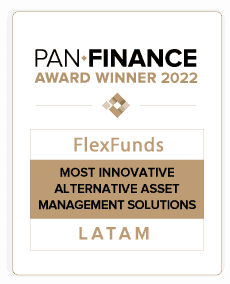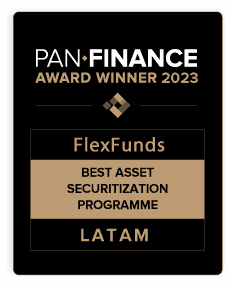- Asset securitization turns a portfolio into tradable securities, offering liquidity and diversification.
- Securitization bonds are backed by income-generating assets such as mortgages or loans.
- FlexFunds facilitates global access to capital markets, optimizing the issuance of listed securities.
- FlexFunds’ programs enhance efficiency, accessibility, and speed in launching independent investment vehicles through an asset securitization program that creates exchange-traded products (ETPs).
Established in the 1970s, asset securitization is one of the most popular financial instruments for raising capital in the stock market, transforming an asset or portfolio into tradable securities, commonly known as securitization bonds.
In a constantly changing economic environment with challenges facing asset managers, taking advantage of securitization bonds is key to optimizing financial strategies and ensuring sustainable growth while diversifying investment portfolios, as highlighted by FlexFunds.
This market is valued at around $13 trillion globally and has evolved since the 2007 subprime mortgage crisis, with improved lending standards, lower household leverage in markets like the U.S., and generally stronger frameworks, as reported by U.S. bank JP Morgan1.
Currently, “securitization is a useful tool for addressing risk aversion among capital market participants. When combined with proper regulations, securitization can be a powerful tool to promote economic growth and capital market development in emerging and developing markets,” according to an article by José Ramón Tora for IDB Invest2.
FlexFunds, a platform dedicated to creating and launching investment vehicles, and that offers one of the most advanced securitization programs in the market, explains what this financial instrument entails, the types available, and the key factors to consider.
What are securitization bonds?
In practical terms, the securitization process involves pooling a series of income-generating assets, such as mortgages or loans, which are then transferred to a special-purpose vehicle (SPV) known as a securitization fund, operating as a separate entity.
These securitization funds repackage the assets into securities, which are later issued on the market, providing liquidity for the originator and offering a mechanism to diversify funding sources.
In an increasingly competitive financial environment, FlexFunds’ ability to design and launch investment vehicles (ETPs) in a short timeframe offers a significant advantage, maximizing liquidity and minimizing associated risks.
The securities issued are known as securitization bonds in the markets. These bonds are backed by the assets transferred by the entity seeking financing for the formation of the fund.
The bond payments, which are isolated in the event of the originator’s bankruptcy3, come from the cash flows of the assets backing them, according to the economic dictionary of Mexican media outlet Expansión.
Types of securitization bonds in the market
Securitization bonds are classified into different categories based on the asset pool transferred by the entity seeking financing and the type of fund created with them. Some of the most popular bonds are those issued by mortgage securitization funds, which can be backed by residential or commercial mortgages.
Depending on financial authorities’ classifications, categories may vary, but generally, other popular securitization bond groups include those backed by corporate promissory notes (asset-backed commercial paper).
There are also securitization bonds backed by debt (collateralized debt obligations), such as corporate debt or accounts receivable. Additionally, there is another class of securities (asset-backed securities) associated with a broader set of underlying assets “held by various financial institutions, such as banks, credit unions, and other lenders”, including student or auto loans, explains Canadian financial education platform Corporate Finance Institute4.
Securitization allows originator entities to access liquidity and diversify funding sources. By transforming assets into tradable securities, a wide range of opportunities opens up for both issuers and investors, who benefit from improved market access and greater risk management flexibility.
What are the advantages and considerations of securitization bonds?
Securitization offers issuers greater market exposure by providing them with better access to capital and international private banking, just as FlexFunds does, which in practical terms simplifies the distribution of these instruments.
FlexFunds’ programs aim not only to facilitate global access but also to improve asset class diversification, as well as speed and efficiency (issuances launched in 6 to 8 weeks), real-time access to information, and integrated management (through trusted financial and legal institutions).
FlexFunds positions itself as a key partner in the securitization process, providing advanced solutions for issuing listed securities in international markets. With tools like FlexPortfolio, Flex Private Program, and FlexFeeder, asset managers can access global markets quickly and efficiently.
Regarding aspects to consider, José Ramón Tora of IDB Invest points out that “securitization can be a relatively complex product and involve a cumbersome process for new issuers. The key is working with clients throughout the process, before and after the issuance of the securities.”
Another consideration with these instruments relates to default risks, tied to the payment rights backing the securitization bonds, as well as the impact of rising interest rates on loans.
These are specialized financing instruments that require the expertise of asset managers for effective integration into their clients’ portfolios, considering typical aspects like risk profile and horizon, as well as the specific conditions of each market.
FlexFunds’ instruments aim to optimize the experience with offerings like FlexPortfolio, which empowers portfolio managers with listed ETPs, offering efficiency and accessibility. Another solution, called Flex Private Program, provides clients with personalized management, ideal for those seeking flexibility in structuring securitized assets, while FlexFeeder helps securitize private fund shares to improve global distribution by creating a listed security. These tools can facilitate the issuance of securities in international markets using platforms like Euroclear, improving the accessibility and distribution of these repackaged assets.
In an increasingly competitive financial environment, FlexFunds’ ability to design and launch ETPs in short timeframes provides a significant advantage, maximizing liquidity and minimizing associated risks. Securitization has become an essential tool in the financial world, allowing originator entities to access liquidity and diversify funding sources efficiently. By transforming assets into listed securities, it opens up opportunities for both issuers and investors, who can benefit from better market access and greater flexibility in risk management.
Sources:
1https://am.jpmorgan.com/sg/en/asset-management/per/investment-ideas/securitisation-then-and-now/
2https://idbinvest.org/en/blog/development-impact/securitization-tool-issuers-reallocate-credit-risk-and-widen-investor-base
3https://www.expansion.com/diccionario-economico/bono-de-titulizacion.html
4https://corporatefinanceinstitute.com/resources/fixed-income/asset-backed-securities-abs/







